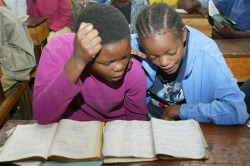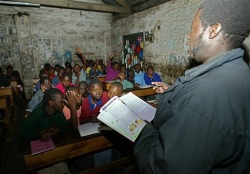Kenya: Education
Sarah Ambrose
Kenya Education Paper
World History – Hjelmgren
May 19, 2009
How Do You Spell Relief? E - D - U - C - A - T - I - O – N.
Unlike in our parent’s day, finding relief was not as easy as taking a “ROLAIDS” anti-acid tablet when it came to turning around the educational system in Kenya. That probably wasn’t on the mind of the 1963 newly elected Kenyan president when his country first gained independence from British colonial rule, but fixing the educational system and economy was. Challenged by poverty and an uneducated population, by 2003, the Kenyan government put into place a universal free and public primary education to start to meet the needs of its citizens. The current educational issues in Kenya reflect the negative impact the British colonization had on Kenya’s indigenous ethnic groups, particularly as it relates to educating its girls and women.
Colonization of Kenya did not meet the educational needs of its people, in fact, they suffered as a result. Under colonial rule, educating the Kenyan people, especially women, was not a priority (Encyclopedia Britannica). Instead, the British controlled the people in order to use Kenyan labor to construct a railroad or to perform basic skills in farming. The British promoted segregation as missionaries and Islamic groups set up separate schools for Whites, Asians and Africans (World Education Encyclopedia). Children who attended were taught western values and were made to feel inferior to the white colonists. There was no unified African history or heritage taught, therefore, national pride and identity was lost during this period (World Education Encyclopedia). Fees were charged to families for children to attend school yet most were poor and could not afford schooling. Indigenous customs, such as early marriages, allowed very young daughters to be exchanged for livestock (Africa News Service). The distance from the home to the school prevented girls from attending school as they had to care for their own young children or herd cattle. Boys were sent to school because males in Kenya owned property and were considered the bread winners. The British colonists overlooked wife beating, rape and mutilation as common Kenyan practices (Stanford). Uneducated girls and women continued to be considered lower class citizens during this time and were not provided equal opportunity for education or improvement (CREAW). Therefore, little improvement was made during the colonial occupation.
After independence, the Kenyan government made swift changes to correct the educational issues left unresolved by the British colonial government. Reforming the educational system started with providing primary schooling to all children, replacing segregated schools with government run schools, and abolishing fees for the primary grades. A major governmental challenge has been to provide access to education for the nomadic families in rural areas whose income depends on grazing livestock over long distances. The Kenyan government and outside organizations are situating mobile classrooms for nomadic children close to water holes for their herds (Africa News Service). Additionally, laws have been changed to protect children and arrest parents who arrange early marriages and now support is available for girls to attend school if they become pregnant (Africa Renewal). One of the most visible results of increased education relates to the battle of combating HIV/AIDS. The work done to stop the transmission of the infection from the mother to the newborn has increased and this has helped to reduce the number of infants infected with HIV/AIDS(UNICEF). This not only prevents children from becoming orphans, but promotes both a healthy mother and child available to join the work force. High level conferences are being held to research the effects of education on the population. UN Secretary–General Kofi Annan stated at one of them that “study after study has taught us that there is no tool for development more effective than the education of girls. No other policy is as likely to raise economic productivity, lower infant and maternal mortality, improve nutrition and promote health, including the prevention of HIV/AIDS. No other policy is as powerful in increasing the chances of education for the next generation” (Africa Renewal). According to Michael Fleshman, author of Giant Step for Kenya’s Schools, “analysts also note that Kenya is among the few African countries where a greater proportion of all school-aged girls, 73 per cent, enroll in primary education than do boys, 71 per cent of whom attend classes” (Africa Renewal). Another source “ranks Kenya 10th out of 46 countries in the Sub-Saharan African region . . . and is one of Africa’s most developed countries” (Heritage Foundation). With this momentum, time will only tell how soon a difference can be made in Kenya with greater numbers of girls who have been educated.
The changes that have been made will benefit Kenya in the years to come as women enter higher education and the workforce. The fact that Kenya’s government focused on education as soon as it became independent proves that it was serious about providing its population with access to knowledge and a better life. The British colonial government ignored these issues and put the country on hold which challenged the Kenyan government to act
swiftly to save its country. Now Kenya is on its way to becoming one of the most productive countries in Africa.
Last Updated By Sarah Ambrose on May 22, 2009
Kenya Education Paper
World History – Hjelmgren
May 19, 2009
How Do You Spell Relief? E - D - U - C - A - T - I - O – N.
Unlike in our parent’s day, finding relief was not as easy as taking a “ROLAIDS” anti-acid tablet when it came to turning around the educational system in Kenya. That probably wasn’t on the mind of the 1963 newly elected Kenyan president when his country first gained independence from British colonial rule, but fixing the educational system and economy was. Challenged by poverty and an uneducated population, by 2003, the Kenyan government put into place a universal free and public primary education to start to meet the needs of its citizens. The current educational issues in Kenya reflect the negative impact the British colonization had on Kenya’s indigenous ethnic groups, particularly as it relates to educating its girls and women.
Colonization of Kenya did not meet the educational needs of its people, in fact, they suffered as a result. Under colonial rule, educating the Kenyan people, especially women, was not a priority (Encyclopedia Britannica). Instead, the British controlled the people in order to use Kenyan labor to construct a railroad or to perform basic skills in farming. The British promoted segregation as missionaries and Islamic groups set up separate schools for Whites, Asians and Africans (World Education Encyclopedia). Children who attended were taught western values and were made to feel inferior to the white colonists. There was no unified African history or heritage taught, therefore, national pride and identity was lost during this period (World Education Encyclopedia). Fees were charged to families for children to attend school yet most were poor and could not afford schooling. Indigenous customs, such as early marriages, allowed very young daughters to be exchanged for livestock (Africa News Service). The distance from the home to the school prevented girls from attending school as they had to care for their own young children or herd cattle. Boys were sent to school because males in Kenya owned property and were considered the bread winners. The British colonists overlooked wife beating, rape and mutilation as common Kenyan practices (Stanford). Uneducated girls and women continued to be considered lower class citizens during this time and were not provided equal opportunity for education or improvement (CREAW). Therefore, little improvement was made during the colonial occupation.
After independence, the Kenyan government made swift changes to correct the educational issues left unresolved by the British colonial government. Reforming the educational system started with providing primary schooling to all children, replacing segregated schools with government run schools, and abolishing fees for the primary grades. A major governmental challenge has been to provide access to education for the nomadic families in rural areas whose income depends on grazing livestock over long distances. The Kenyan government and outside organizations are situating mobile classrooms for nomadic children close to water holes for their herds (Africa News Service). Additionally, laws have been changed to protect children and arrest parents who arrange early marriages and now support is available for girls to attend school if they become pregnant (Africa Renewal). One of the most visible results of increased education relates to the battle of combating HIV/AIDS. The work done to stop the transmission of the infection from the mother to the newborn has increased and this has helped to reduce the number of infants infected with HIV/AIDS(UNICEF). This not only prevents children from becoming orphans, but promotes both a healthy mother and child available to join the work force. High level conferences are being held to research the effects of education on the population. UN Secretary–General Kofi Annan stated at one of them that “study after study has taught us that there is no tool for development more effective than the education of girls. No other policy is as likely to raise economic productivity, lower infant and maternal mortality, improve nutrition and promote health, including the prevention of HIV/AIDS. No other policy is as powerful in increasing the chances of education for the next generation” (Africa Renewal). According to Michael Fleshman, author of Giant Step for Kenya’s Schools, “analysts also note that Kenya is among the few African countries where a greater proportion of all school-aged girls, 73 per cent, enroll in primary education than do boys, 71 per cent of whom attend classes” (Africa Renewal). Another source “ranks Kenya 10th out of 46 countries in the Sub-Saharan African region . . . and is one of Africa’s most developed countries” (Heritage Foundation). With this momentum, time will only tell how soon a difference can be made in Kenya with greater numbers of girls who have been educated.
The changes that have been made will benefit Kenya in the years to come as women enter higher education and the workforce. The fact that Kenya’s government focused on education as soon as it became independent proves that it was serious about providing its population with access to knowledge and a better life. The British colonial government ignored these issues and put the country on hold which challenged the Kenyan government to act
swiftly to save its country. Now Kenya is on its way to becoming one of the most productive countries in Africa.
Last Updated By Sarah Ambrose on May 22, 2009


